The Engineering Leadership & Wellbeing Newsletter 🌱 #15
“HAY” there 👋🏼
It’s common knowledge among developers that testing in production is a bad practice. So, why do developers sometimes test their skills in the production environment?
“As a beginner Engineering Manager,” says Tomek, CEO of codequest, “I dreamed of having a testing environment to practice all the skills I was terrible at as a leader.”
The solution? A safe testing ground bundled into an intimate and interactive workshop called The Effective Engineering Manager Course.
Be sure to secure your spot for June 26-27. It’s a two-day course for a small group (8 people) based on role-playing boss ceremonies in software engineering leadership.
Topics for the day: Burnout, Anti-patterns, Hiring, Engineering strategy, Cognitive conflict, AI art, Gamification
Get Your Ultimate Guide to Burnout in Software Engineering
If the constant pressure of building technology has you feeling overwhelmed, disillusioned, and completely drained, you might be on the path to burnout. Check out some strategies here to recalibrate and rekindle your enthusiasm and optimism for turning ideas into cool products.
Read more: What Is Burnout in Software Engineering? (+ Bonus Burnout Self-Test)
Anti-Patterns in Engineering Leadership
Will Larson, CTO at Carta, explores three surprising pitfalls that engineering leaders often face:
🚫 Avoiding Micromanagement: Larson argues that stepping away from details can lead to disengaged leadership. He recommends "conflict mining" and documenting details to stay connected with the team’s work.
📉 Rejecting Flawed Metrics: Larson suggests that measuring imperfect metrics is better than measuring nothing at all. This approach helps build a better understanding of engineering work among non-technical leaders.
🛡️ Protecting the Team Too Much: Instead of shielding teams from external pressures, Larson advises involving them in decision-making processes to build resilience and better understanding.
Read more: Unexpected Anti-Patterns for Engineering Leaders — Lessons From Stripe, Uber & Carta
How to Change Inefficient Engineering Hiring Practices
highlights inefficiencies in current hiring practices caused by over-engineering, fear of missing the perfect candidate, and concerns over wasting employee time. These issues lead to lengthy processes that often result in missing out on top talent. Building an Engineering Strategy
This article by
outlines building long-term engineering strategies by simplifying evaluations, reducing feedback loops, and leveraging strategic blocks. Utilizing frameworks like DevOps culture and technical debt classification can enhance team performance and product quality.Read more: How to Build Engineering Strategy
How Cognitive Conflict Turns Ideas Into Innovations
Mike Fisher recounts Steve Jobs' rock tumbler story to illustrate the value of cognitive conflict in refining ideas through team debates and discussions. This type of conflict, which arises from differing perspectives, can enhance understanding and innovation. However, not all conflicts are productive. Relationship conflicts, goal conflicts, and process conflicts can disrupt team dynamics and hinder performance.
Why AI Art Sucks
AI companies claim they will "democratize" creativity and eventually replace human artists. So far what I’ve seen is AI-generated art and content that currently lacks depth, originality, and true artistic merit.
Read more: Why AI art will always kind of suck
Gamifying Your Workspace
With employee engagement hitting an 11-year low, it’s time to bring elements of play into our workspace.
Read more: Why gamifying work works (and how to do it right)
Did you like this edition of ENGINEERING LEADERSHIP & WELLBEING 🌱?
If you're looking for a specific subject to read about or maybe would like to collaborate on a project, reach out to me at tomek@howareyou.work.






